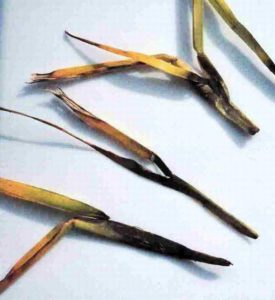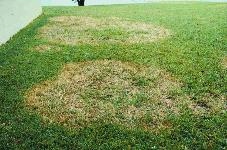Brown patch fungus is a lawn disease triggered by rainfall, excessive irrigation, or extended periods of high humidity resulting in the grass blades being continuously wet for 48 hours or more. This disease is most likely to be observed from November through May when temperatures are below 80 degrees.
Turfgrasses Affected
All warm season turfgrasses, especially St. Augustine and Zoysia can be affected by Brown Patch Fungus.
Symptoms and Signs
The fungus infects the grass blade area closest to the soil, eventually killing the leaf. A soft, dark rot occurs at the base of the leaf, and leaves can be pulled off the stem. The base of a pulled leaf has a rotted odor, but roots are not affected by this fungus (See Figure 1).
The brown patch fungus usually begins as small patches that turn yellow and then reddish brown, brown or straw colored as the leaves start to die. Patches can expand to several feet in diameter (see Figure 2). It is not uncommon to see rings of yellow or brown turf with apparently healthy turf in the center. This disease is often confused with herbicide damage on St. Augustine.
How You Can Help
Irrigate only when necessary and do so only in the early morning hours (between 2-8:00 am) when dew is already present. Since lawn mowers can spread this disease, mow diseased areas last and wash turf clippings off the mower before proceeding to another site.
Please remember that we are only on your property, in most cases, every 60 days. We rely on you, your mower, or agent to keep us informed of any suspicious areas in your lawn. Help us to keep your lawn healthy all year long!
Recovery
For the diseased grass to recover, it must be actively growing. Symptoms do not disappear until new leaves develop and the old leaves are removed by mowing or decomposition. Since this disease normally occurs when grass is not growing rapidly, recovery may be very slow. Fungicides simply stop the disease from spreading – they do not promote growth.
Click Here for More Information on Winter Watering Practices


